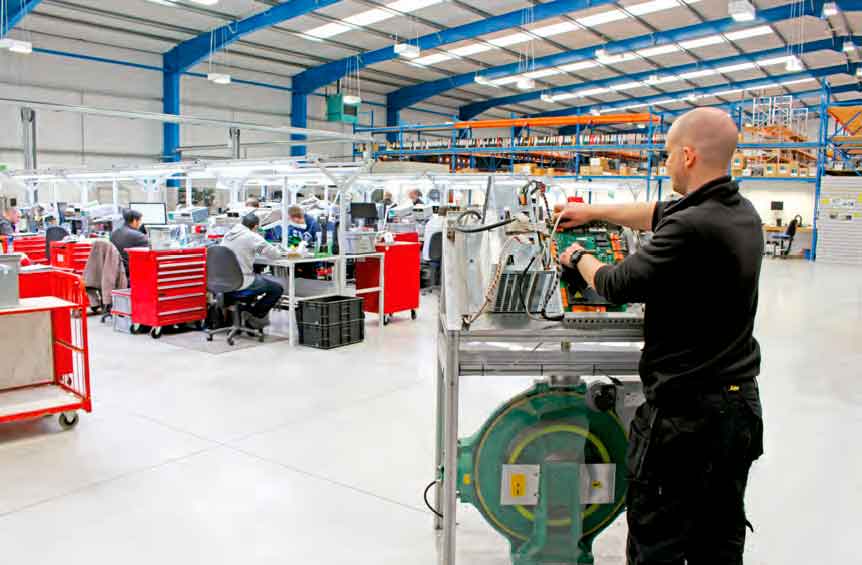Are You Ready for Obsolescence?
Dec 1, 2018

Outlining the importance of an “obsolescence strategy” to keep elevators in order
It’s the sign every elevator owner, operator or user dreads: “Out of Order.” There’s actually a law that relates to the risk factor in seeing such a sign. I call it “Lenehan’s Law,” and it basically states, “As machinery gets older, its chances of breaking down get bigger.”
The truth is, all machinery is set to become obsolete at some point. It’s the nature of the physical world that things wear out. The march of time simply cannot be stopped. We understand this about ourselves and make plans for our own retirement. Extending our quality of life can come from careful planning while we’re still fit and well. In industry, on the other hand, a recent global study showed most companies have experienced at least one unplanned downtime outage over the past three years, costing an average of US$260,000 an hour across all businesses.
The Vanson Bourne global study, sponsored by ServiceMax, from GE Digital, surveyed 450 field service and information-technology decisionmakers in the U.K., U.S., France and Germany across the manufacturing, medical, oil and gas, energy and utilities, telecom, distribution, and logistics and transportation sectors. As well as estimating downtime losses to average US$2 million per year for 82% of businesses, it also concluded that around 70% of companies lack full awareness of when their equipment is due for maintenance, upgrade or replacement.
Advocates of Industry 4.0 and the Industrial Internet of Things promise a future of self-analyzing, hyperconnected machines that tell you when they are about to have a breakdown and preorder the parts to fix themselves. That may well be the future, but where does it leave the vast majority of machinery bought and installed before the revolution? The answer is that it’s all about planning. A good obsolescence strategy will ensure you get the maximum value from previous or new capital investments, in terms of ongoing performance, performance improvement and energy efficiency.
Lifecycle
Step one is to understand that parts and spares prices have a lifecycle. They start at a fair price. Then, as machinery starts to reach obsolescence, they rise dramatically, as parts become hard to find. Later, they drop even more dramatically as original equipment starts to be replaced. However, with smart planning, it’s possible to make use of falling prices and avoid disruption and downtime if legacy equipment is well maintained.
The internet has opened up the spares market so companies can have a spares strategy that does not necessarily rely on the OEM. Having an obsolescence strategy at the outset can help companies avoid buying spare parts at peak prices and avoid the costs of disruption from stress purchasing (e.g., when equipment has already broken down).
Risk Analysis
Carrying out an obsolescence report and a risk analysis is a good first step toward developing a full strategy. Risk planning is best carried out on a rolling timeline using an inclusive framework, taking into account any factors that can contribute to the likelihood and potential impact of obsolescence.
A usual starting point is simply to identify critical assets and then assess the risk of obsolescence in both qualitative and quantitative terms. Once the risks have been identified in relation to each asset, the next step is an assessment of obsolescence likelihood. Data for this can be gathered from everything from the maintenance logs and internal systems to the reliability of the supplier in terms of service-level agreements, service and support. By looking into suppliers’ end-of-line plans, manufacturers can mitigate the risk of discontinued support or technology upgrades.
Strategy
Once you are aware of the risks, a strategy can be developed to minimize the overall obsolescence risk. It can be divided into three parts: repairs, upgrading and spare parts.
Repairs
Assess what can be repaired in the event of a breakdown. Can you wait for a repair? For items that cannot have any downtime, a repair may not be an option, as it will take a minimum of 24 hr., and that’s if the repair supplier has the components in stock needed to complete it.
Which company will carry out the repairs? Which resources does it have? What is its track record? Will it do the work itself or outsource it? A quick company check will help narrow down the list of suppliers.
Upgrading
Upgrading in the middle of unplanned downtime is never recommended, so it is worth considering if the equipment can be upgraded. Which equipment can be upgraded? Which equipment should be upgraded? When should it be upgraded? Simply having a plan that answers these questions will help keep you ahead of the curve.
Due to their rarity, the cost of some obsolete parts can be more than double the cost of a modern equivalent. New equipment comes with a warranty and is more readily available, so you can be confident you will receive ongoing support for years. Aside from these benefits, you can also get others, such as better efficiency and reduced energy costs. You should always consider these benefits, as they can make the payback period on improvements seem quick. A good supplier should have the necessary skills to assist or even set up the replacement before shipping. Planning the upgrade in advance is always the best solution.
Spare Parts
Which spare parts will be needed? Are they in stock? Keeping a good stock of the right spare parts can help mitigate the risk of breakdown disasters and expensive downtime. For items where you have ascertained that repair or upgrade is not an option, but the part is critical to your production, a spare should be kept in your stock so that in the event of a breakdown, you can switch out the faulty unit in minutes. This mitigates downtime and gives you the option to repair the faulty unit and put it back into your stores, reducing future costs on spares management.
Buying spares at the right time can save you a lot of money, compared to purchasing when you are already on breakdown and are factoring in express shipments from wherever the part is, as well as the unit itself possibly being a lot more expensive due to its rarity now that it is obsolete.
In summary, a step-by-step obsolescence plan is essential to avoiding the terminal risks of downtime. There is no silver bullet, but a combined and forward-thinking approach should bring benefits.
Get more of Elevator World. Sign up for our free e-newsletter.









